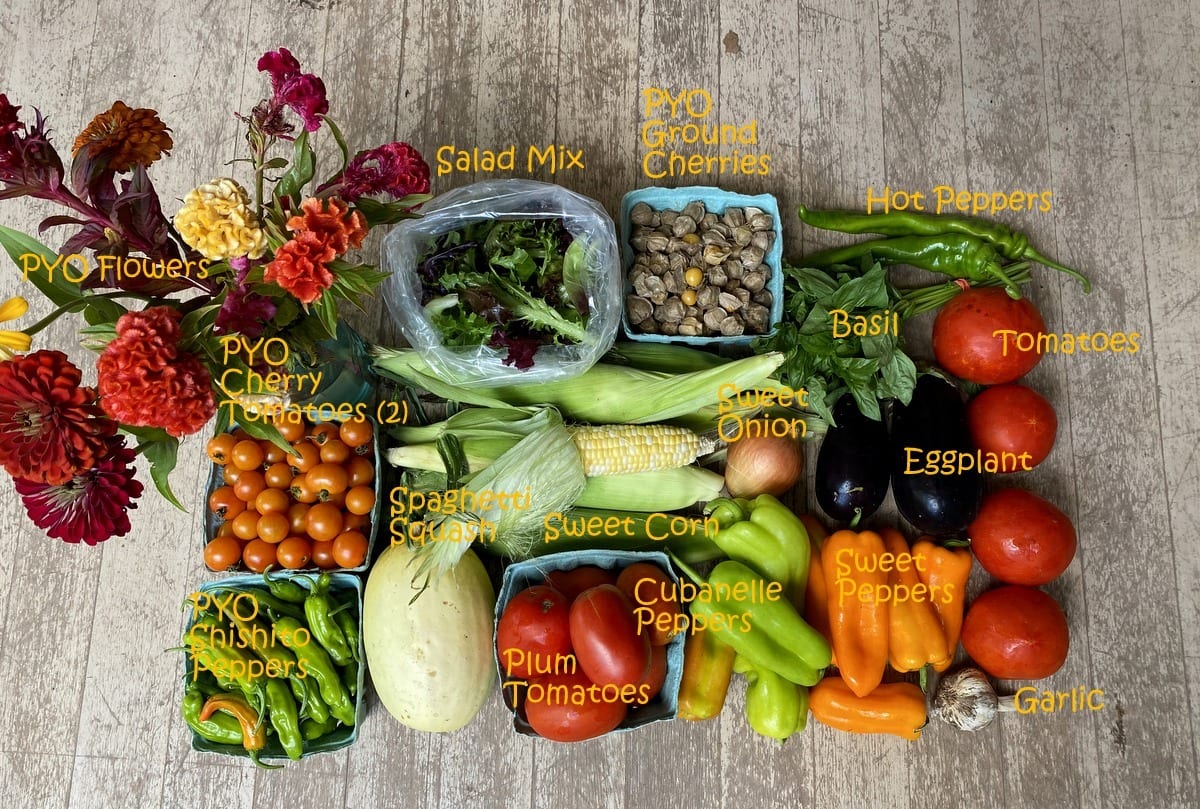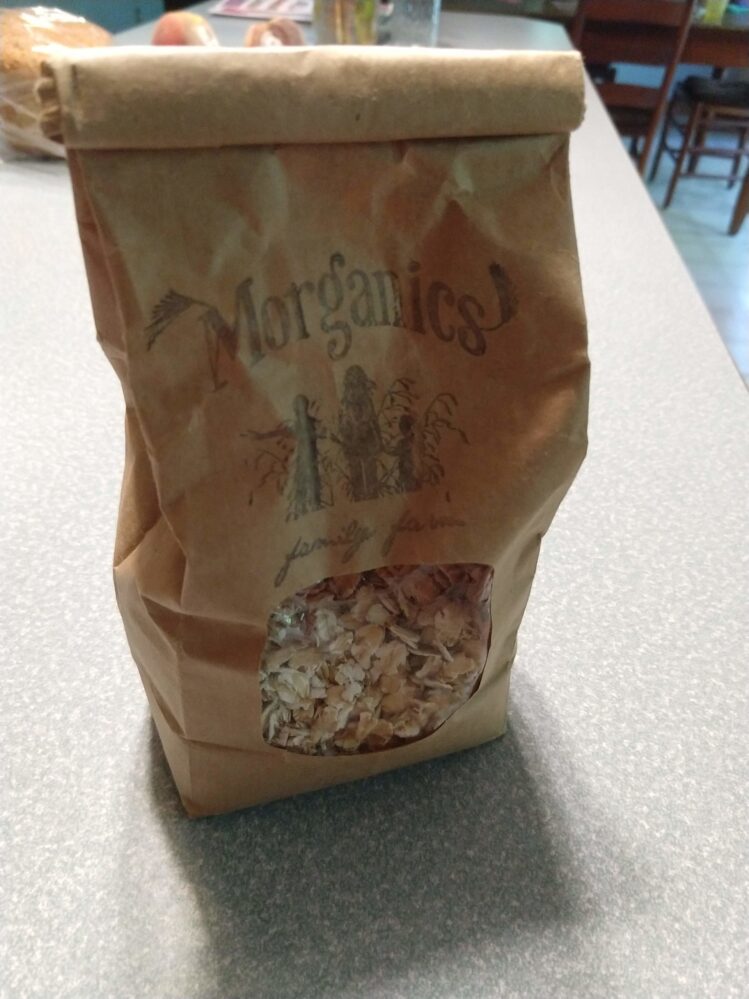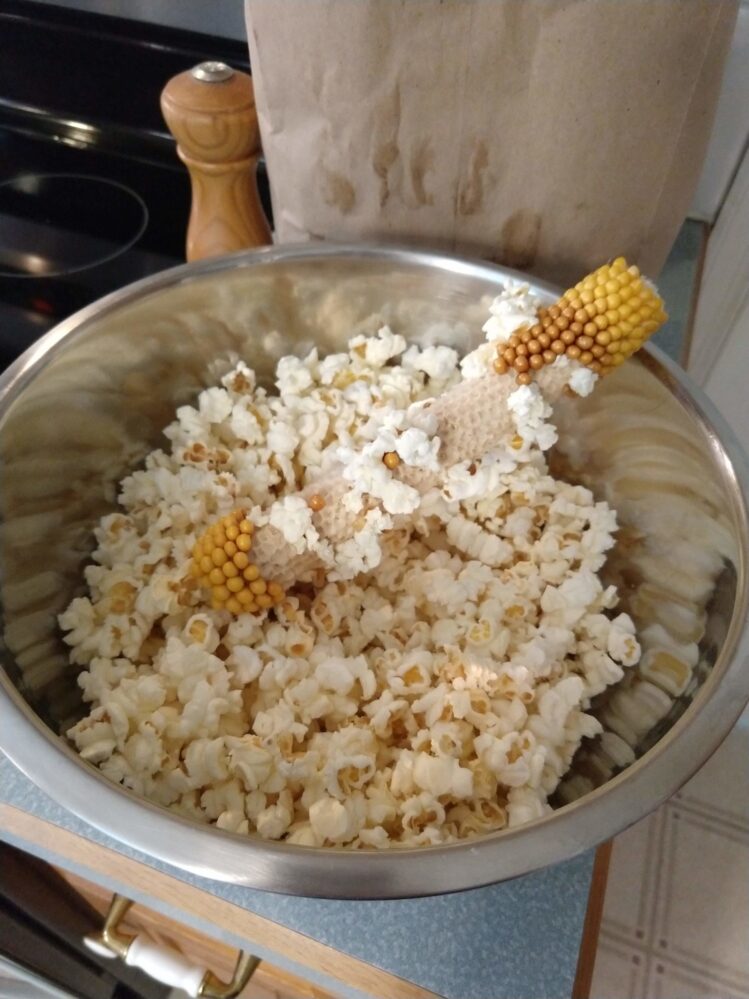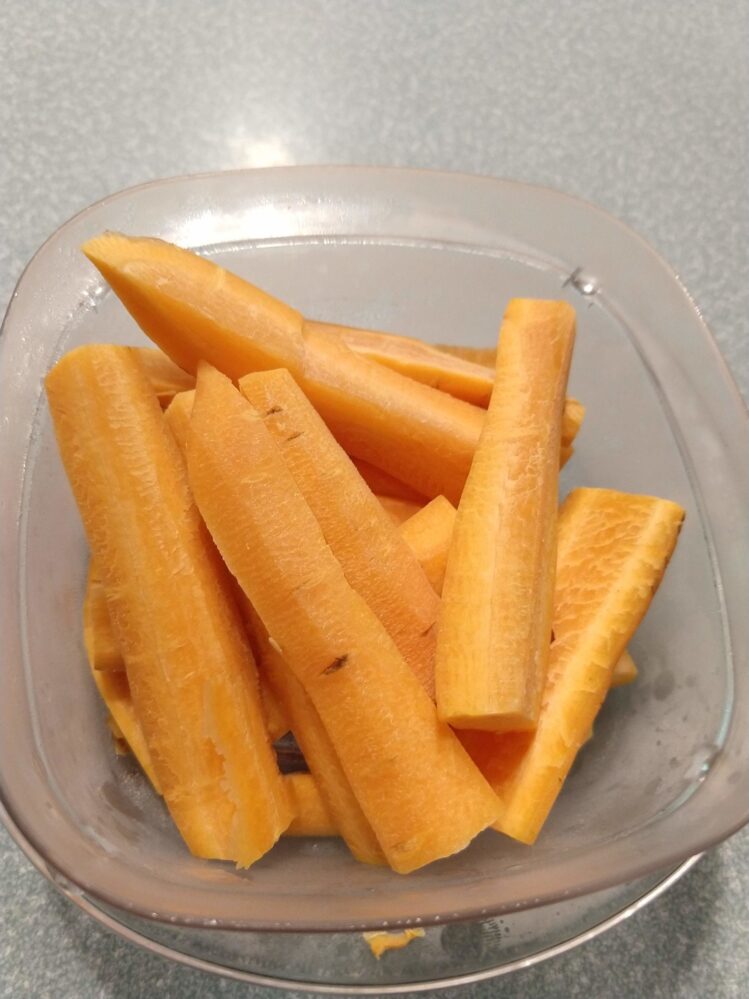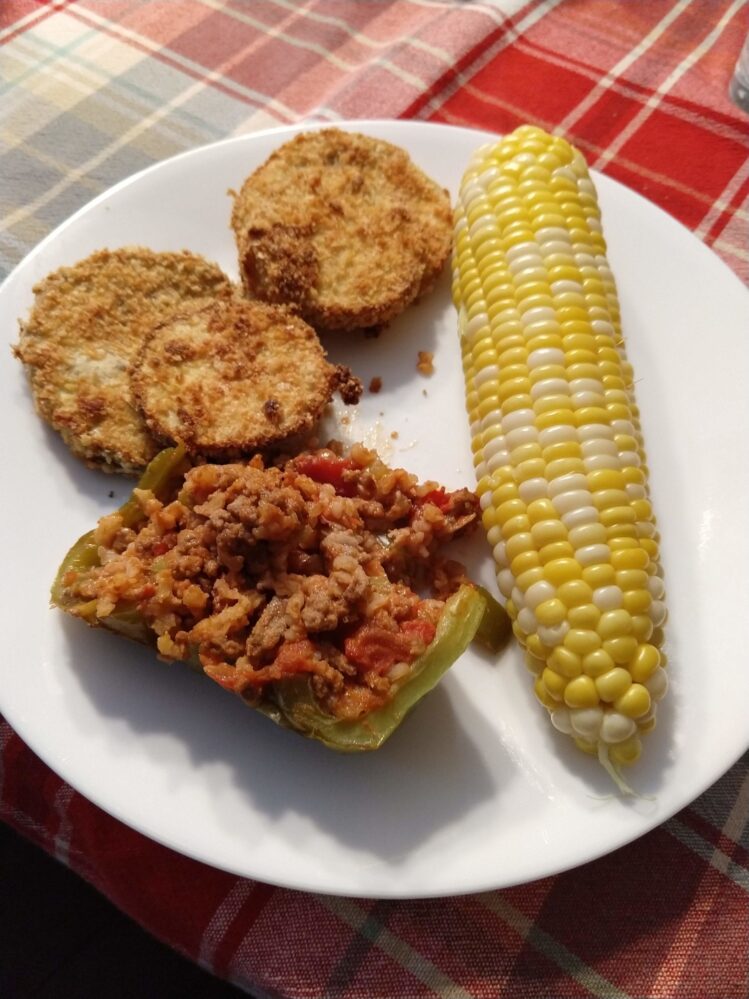Since many people have been spending more time at home, backyard gardens and local farms have become more common sources of food than they were in previous years. I have been caught up in this shift myself, joining a Community Supported Agriculture (CSA) program with my family, for which we pick up a crate full of a variety of produce each week. At the beginning of the pandemic, when grocery stores struggled to keep some products stocked on the shelves, it opened people’s eyes, including my own, to how dependent we are on long and complex supply chains. If that chain were to break down, would I still be able to feed myself through entirely local food producers? My experience with the CSA, increased attention to how our food reaches us, and a recent feature I wrote for NNC’s Buy Fresh Buy Local program got me thinking about how different my diet and experience of shopping for and preparing food might be if I prioritized eating locally produced foods. I decided to devote a week to trying it out.
Local foods carry a range of benefits as described by Buy Fresh Buy Local, including better taste and health benefits from freshly picked, nutrient rich local foods; support for family farms and the local economy; and environmental benefits from reduced transportation and less energy-intensive, chemical heavy production processes. In the book, Going Local, author Michael Shuman writes “Going local does not mean walling off the outside world. It means nurturing locally owned businesses which use local resources sustainably, employ local workers at decent wages and serve primarily local consumers. It means becoming more self sufficient and less dependent on imports. Control moves from the boardrooms of distant corporations and back into the community where it belongs.”
For my week, I decided to try to integrate as much local food into my diet as I could. To start, I had to define “local” food. Would it be grown within a certain distance, processed locally, purchased directly from farmers, or meet some other criteria? I based my week on the USDA’s definition of local food as “the direct or intermediated marketing of food to consumers that is produced and distributed in a limited geographic area.” As long as I could identify the entity that produced the food and it served only a limited geographic area (i.e. no national or large regional distributors) I considered food items to be local. For processed foods like baked goods, condiments, or snacks, I also tried to determine whether they were not only processed locally but made with local ingredients. My goal for the week was to track the local foods I ate and strive to make them the bulk of my food choices.
Results
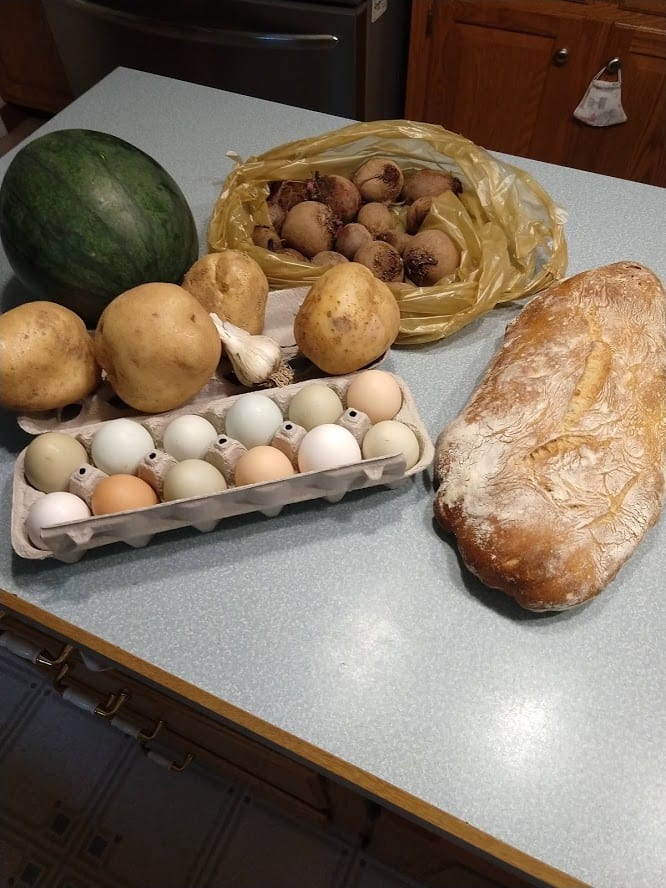 I realized before the week started that eating locally would require me to change my food shopping routine. I wouldn’t be able to get items that matched my definition of local at my regular grocery store. In order to get as much of the food I would need in one stop, I visited a Farmer’s Market on the weekend. I ended up also going to a local bakery, but if I had thought ahead could have gotten bread at the Farmer’s Market as well. This in combination with the produce we had from our CSA and preserved/stored local foods made up most of my food for the week, but I did make one additional trip to a local retail farm market midway through the week intending to pick up some local chicken. Unfortunately they were sold out, but I still added some carrots, locally ground peanut butter, and cheese to my supplies.
I realized before the week started that eating locally would require me to change my food shopping routine. I wouldn’t be able to get items that matched my definition of local at my regular grocery store. In order to get as much of the food I would need in one stop, I visited a Farmer’s Market on the weekend. I ended up also going to a local bakery, but if I had thought ahead could have gotten bread at the Farmer’s Market as well. This in combination with the produce we had from our CSA and preserved/stored local foods made up most of my food for the week, but I did make one additional trip to a local retail farm market midway through the week intending to pick up some local chicken. Unfortunately they were sold out, but I still added some carrots, locally ground peanut butter, and cheese to my supplies.
All local foods eaten throughout the week: eggs, milk, cheese*, peanut butter*, bread*, spelt flour, oats, potatoes, garlic, onion, beets, varied peppers, cherry tomatoes, escarole, eggplant, salad greens, carrots, sweet corn, popcorn, zucchini, ground cherries, watermelon, peaches, cantaloupe, pears (canned), blueberries (frozen), strawberries (jam), applesauce (frozen), maple syrup, honey
*It was unclear from product labeling whether the ingredients in these processed foods were locally produced.
The wide variety of local foods I had made for varied breakfasts, lunches, and snacks that were nearly entirely comprised of local foods, with the exception of butter/oil, salt, and seasonings. Breakfasts included eggs with potatoes and toast, blueberry oatmeal with maple syrup, and my favorite, french toast.


Local rolled oats with frozen blueberries from a bush in my backyard were a big step up from instant packets of oatmeal.
For lunches I made a few variations of a similar meal with homemade pasta I prepared on Sunday using local spelt flour, salads, fruit, and leftovers from previous nights’ dinners. Fruit, especially peaches, or peanut butter toast made good snacks when I wanted something sweet, and popcorn microwaved on the cob in a paper bag provided a salty option.
Dinners typically included some non-local pantry staples (pasta, rice) and I didn’t explore local meat options for this week beyond the local chicken farmer who was sold out. However, side dishes primarily consisted of local produce, and a variety of local items were integrated into each meal. Overall, I was happy with the balance of foods I had and impressed that local items certainly made up the majority of what I ate for the week!
Local corn, eggplant, peppers, tomatoes, potatoes, beets, and more were the stars of varied and colorful dinners.
Takeaways
Challenges:
- Labeling – Some things offered at markets (e.g. coffee, baked goods, olive oil) are perhaps locally processed or packaged but not locally grown. When purchasing foods other than fruit and vegetables, it could be challenging to tell what was truly local or what was just processed or packaged locally. Better food labeling would be one solution to this, and for farmers’ markets specifically you can check the market’s policy on any requirements for vendors being producer-only, local, organic, etc.
- Time required – Particularly when I was packing lunch to go in to work, I noticed that it took me a bit longer to prepare my meals since I was using more fresh ingredients than pre-prepared or packaged foods. However, I was often also preparing foods that I wasn’t used to making, and I expect that continuing to eat locally beyond one week would result in being able to make those new recipes more quickly and having a better routine for meal preparation.
Everyone who eats locally won’t have the same experience I did, and may run up against different challenges. This would be more difficult in winter, for example, or without access to a car, and depends on what types of farmer’s markets or other retail options are accessible in a given area.
Benefits:
- Sense of community – It sounds a little odd, but I felt a strong sense of being connected to others when eating vegetables from my local CSA. I get an email from the farmer each week and see her at pick up, and we have a shared community. The CSA maintains a blog with recipes from members throughout the years that use share items (farmers often have great suggestions for ways to use fresh produce – ask growers at your farmers’ market for recommendations!) I feel that she puts a ton of work into growing food because she thinks it’s important for our community to have healthy local food, as well as to make a living. “Someone who cares about my wellbeing and my community’s wellbeing grew this food,” rings much more true when eating local food as opposed to when I eat a banana from the grocery store.
- Health and Nutrition – As I made my food choices based on whether or not food was local, I also ended up choosing food with less sugar and simple carbohydrates, more vegetables, and less meat. I also planned ahead of time for my meals since I wanted to purchase most of my food at the farmers market, so I didn’t find myself without a plan for meals left to get takeout or decide to eat unhealthy options at the last minute.
- Taste – As noted on the Buy Fresh Buy Local website, local food tastes great! I noticed some of the biggest differences from typical grocery store options in my local bread, lettuce, tomatoes, popcorn, peanut butter, and milk. Getting creative with fresh ingredients also led to some delicious meals, breaking me out of a rut of having the same cereal for breakfast or similar lunches.
- Reduced Waste – An unintended benefit of eating more locally was that I ended up producing less waste – local foods came with less packaging, and when they did have packaging it was less likely to be plastic packaging. Prior to this week, I was already in the habit of getting milk from a local dairy farm in glass bottles, which are washed, returned, and reused. Local eggs came in a cardboard carton, while eggs at the grocery store are often in styrofoam.
Other Thoughts:
- Comparing cost – Does it cost more to eat locally? I found both higher prices on some individual items at farmers’ markets (perhaps reflecting more responsible growing practices and better taste and nutrition), and opportunities for cost saving by buying in season. It’s also difficult to estimate the cost for items from the CSA, as you purchase membership at the beginning of the season and then receive a different number of items each week. Local food is not uniformly more or less expensive than conventional food in my experience. Rather, cost is one factor to be weighed against the other benefits and challenges when making decisions about where to purchase food.
- If I expanded “local” to locally processed my options would greatly expand – baked goods, ice cream, ready-to-go meals, beverages, condiments, and other foods are often sold at farmers markets or similar retailers and emphasize local ingredients though they may also include ingredients that are shipped to them for processing. Although I didn’t include those options for this week, local processed products can bring benefits too, circulating more money within the community and often using more environmentally friendly practices and more natural ingredients than large or national producers.
- The longer one commits to eating locally, the easier it might become. Things I may not have had locally are available locally, but may need to be preserved from when they are in season or weren’t available at the specific locations I visited. The question isn’t whether or not they can be produced, but I knew where to find them and had thought ahead that I would need them. Committing to this more long term, the supplies in my pantry or fridge would shift over time so more of what I use could be local.

This week also happened to be the week my family made freezer corn, preparing 100 ears of local corn to be kept in the freezer through the winter. We had some frozen blueberries from earlier in the summer and strawberry jam as well. These types of preserved local foods are not something I could decide to switch over to in one day, but as time passes and new habits around food are formed, more local foods can be integrated into your diet year-round in this way.
This week was a surprising exercise for me in thinking about where my food comes from, realizing how much local food I already rely on, and finding new ways to enjoy local food that I will certainly carry forward and add to my regular diet. I’d recommend that everyone visits their local farmers market or farm stand and explores how local food options could feature more heavily in their diet. It doesn’t have to happen all at once – try starting by purchasing only local eggs or meat, or having one all-local meal on the day of your nearest farmers’ market. Participate in community gardens and have a hand in growing your own local food while meeting and learning from other gardeners. Try a couple of recipes for preserving summer crops by canning, freezing, or making jam so you can continue to enjoy local options in the colder months. Any of these steps help your dollars circulate within the local economy, support small producers who use more environmentally-friendly practices than industrial farms, discover new favorite foods, and enhance the nutrients you receive from your diet.
Eating locally is also a great example of how individual actions and community-level changes rely on one another to be successful. I was able to eat a lot of local food, but it would have been even simpler and would likely draw more people in if my grocery store had a large selection of food from local producers, if restaurants were motivated to purchase mostly local ingredients, and if information about where food is produced was easily accessible. At the same time, deciding to eat locally in the current local food landscape could help demonstrate the public desire for those community-level solutions and begin to build social norms around knowing where your food comes from and valuing local food producers. We all have a role to play in building sustainable communities, and focusing on local foods is a delicious way to start!

